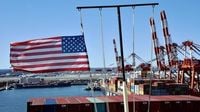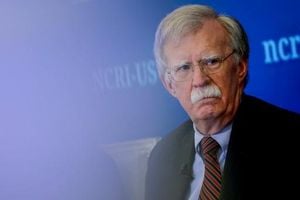On September 3, 2025, Taiwanese electronics giant Inventec announced plans to invest up to $85 million in new manufacturing operations in Katy, Texas—a move emblematic of the seismic shifts rippling through global trade as the United States, under President Donald Trump, escalates its tariff policies. The company’s decision to establish a foothold in the Houston area is not just about business expansion; it’s a direct response to the threat of steep 32% tariffs on imports from Taiwan, part of a broader wave of protectionist measures reshaping the global economic landscape.
According to Covering Katy News, Inventec’s first step involves converting a 52,000-square-foot warehouse in Katy’s Park 10 Ninety Nine industrial complex into an advanced electronic component assembly plant. Lease documents reveal that the site’s total footprint exceeds 530,000 square feet, with the initial phase—currently remodeling 40,000 square feet—representing just the beginning of what could become a massive manufacturing hub. State filings confirm that Inventec plans to spend $55 million on improvements, aiming to have the first phase completed by October 31, 2025.
Inventec’s president, Jack Tsai, explained earlier this year that Texas was chosen for its proximity to Mexico and its robust power infrastructure—key factors for any electronics manufacturer seeking to weather the volatility of today’s trade environment. The Katy facility, located near Katy Asian Town, also places Inventec in a community with established Asian business ties and cultural amenities, a strategic advantage for the Taiwanese firm as it seeks to “meet customer shipment location requirements, actively pursue new customers and markets, and mitigate the impact of fluctuations in U.S. tariff policies,” according to a company statement to the Taiwan Stock Exchange.
Inventec’s move is part of a wider trend among Taiwanese manufacturers. Facing the specter of U.S. tariffs, Taiwan’s government has pledged to support its companies in increasing U.S. investments and purchases, aiming to reduce the island’s trade surplus with the United States and maintain access to crucial markets. For Inventec, which specializes in contract manufacturing of notebooks and AI servers, the stakes are particularly high: any disruption in trans-Pacific trade could jeopardize relationships with major technology clients and threaten the company’s global competitiveness.
The urgency behind Inventec’s decision is underscored by the broader context of U.S. trade policy in 2025. As AINVEST reports, the effective U.S. tariff rate has soared to 15.8% as of August 2025, up from just 2.3% at the end of 2024. President Trump’s administration has imposed a dizzying array of tariffs—ranging from 10% to 50%—on goods from China, Canada, Mexico, India, Brazil, and more. The policy is designed to protect domestic industries, but it’s sending shockwaves through global supply chains, business sentiment, and financial markets.
According to a model-based analysis by the Federal Reserve Bank of San Francisco, these tariff hikes—25% on Canadian and Mexican goods, 30% on Chinese imports, 10% on other goods—could reduce U.S. inflation-adjusted income by 0.4% by 2028. The Tax Foundation projects that, while Trump’s tariffs could generate $2.3 trillion in revenue over the next decade, they are expected to shrink U.S. GDP by 0.9% even before factoring in possible foreign retaliation. J.P. Morgan Global Research warns that such a sharp increase in tariffs risks stifling global growth, disrupting supply chains, and dampening business confidence.
The impact on specific sectors has been immediate and dramatic. For instance, as reported on September 4, 2025, U.S. bicycle imports have plummeted amid the ongoing tariff war, illustrating how protectionist policies are reshaping entire industries. The end of the de minimis exemption—which previously allowed goods under $800 to enter the U.S. duty-free—on August 29, 2025, has further tightened the screws on importers, forcing them to either absorb the added costs or pass them on to consumers.
Trump’s months-long plan to impose reciprocal tariffs finally took effect in August, with countries worldwide now facing rates from 10% to 50%, depending on their trade agreements with the U.S. Notably, steel and aluminum imports now face a 50% tariff, while imported vehicles and car parts are hit with a 25% duty. Chinese imports valued under $800 face a 54% tariff. Meanwhile, a 17% tariff on Mexican tomatoes and a 10% duty on Canadian and Mexican potash imports have also come into force. Despite a federal appeals court ruling most of these tariffs illegal, they remain in place until at least mid-October 2025.
The global financial landscape is shifting in response. The U.S. dollar, long the world’s reserve currency, is under pressure as central banks—especially in emerging markets—diversify into gold and non-dollar currencies. U.S. News & World Report notes that Russia and China now conduct nearly 95% of their bilateral trade in rubles and yuan. The weakening dollar has, in turn, made emerging market (EM) assets more attractive. In 2025, EM local currency bonds have outperformed U.S. equities, returning 7.7% year-to-date compared to a 4% decline for American stocks, according to Morgan Stanley. Investors are flocking to dollar-short and gold-long strategies, hedging against further dollar depreciation and tariff-induced volatility.
Yet, the benefits of this shift are uneven. Countries with heavy U.S. trade exposure, such as Brazil and Mexico, are grappling with currency volatility and inflationary pressures, while others with less exposure are reaping capital inflows. The Trump administration’s controversial proposal to force foreign holders of U.S. Treasurys to exchange them for long-term, zero-coupon bonds has drawn sharp criticism, with some analysts likening it to a de facto default—potentially undermining confidence in dollar assets and accelerating capital flight to EM markets.
For investors and multinational corporations alike, the new trade reality demands agility. Inventec’s rapid expansion in Texas is a case in point. The company’s strategic pivot, supported by both private capital and government encouragement, exemplifies how global businesses are reconfiguring supply chains to hedge against policy risk and maintain market access. As Inventec’s president put it, Texas offers the “proximity to Mexico and robust power infrastructure” needed to thrive amid uncertainty.
Meanwhile, the expiration of the 90-day tariff pause and ongoing trade negotiations keep markets on edge. The future of U.S. dollar dominance remains uncertain, with the rise of alternative currencies, central bank digital currencies (CBDCs), and gold-backed assets threatening to erode its position further. For now, defensive equities, real assets like infrastructure, and EM local currency bonds offer some resilience in a volatile environment.
As tariffs continue to reshape the global economy, the story of Inventec in Katy, Texas, serves as a microcosm of the broader transformation underway. With supply chains in flux and financial markets recalibrating, the coming months will test the adaptability of businesses, investors, and policymakers alike.






